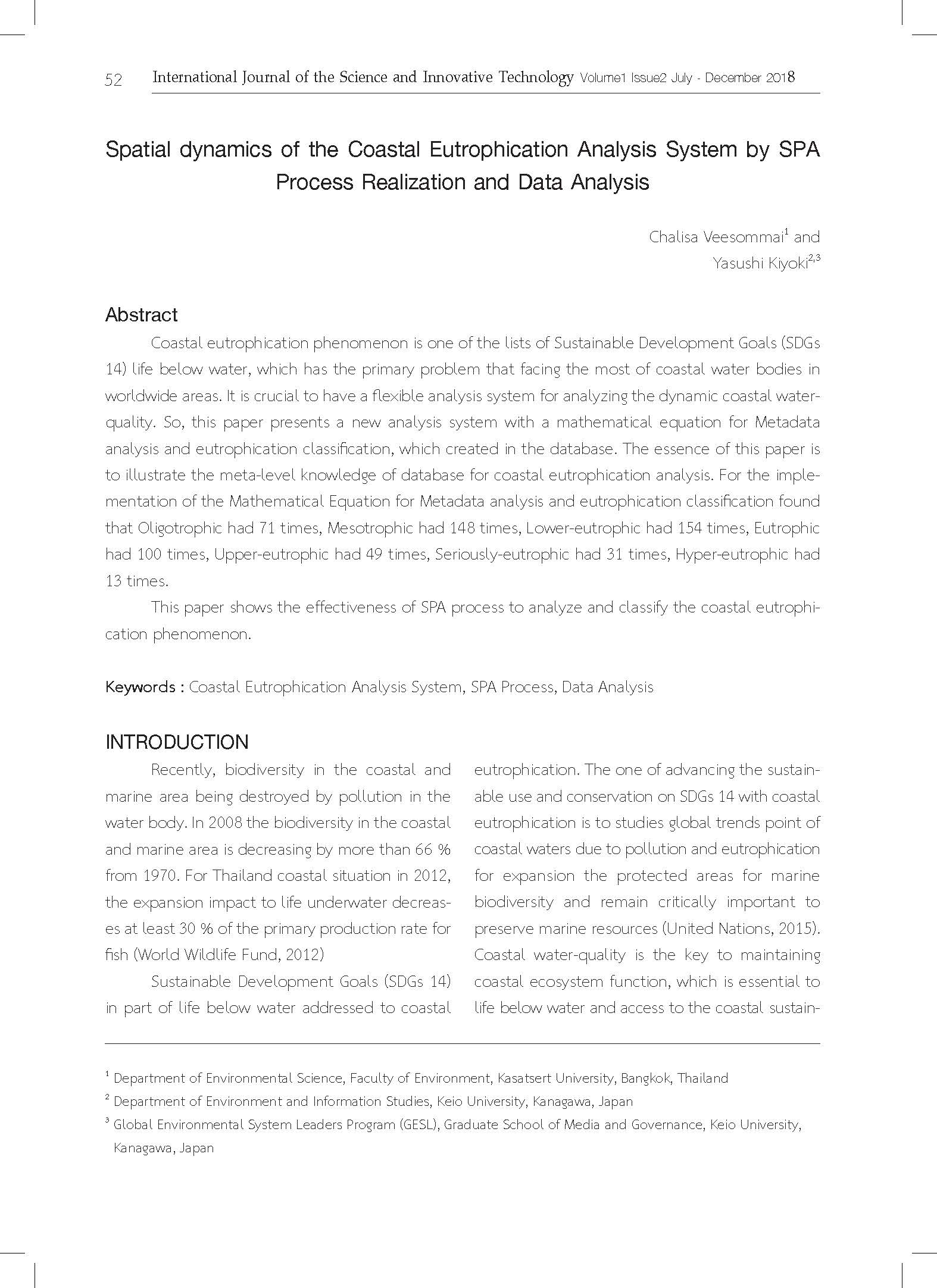A spatial dynamic of the Coastal Eutrophication Analysis System by SPA Process realization and Data Analysis
Main Article Content
Abstract
One of the targets of Sustainable Development Goals (SDGs 14) life below water addressed to coastal eutrophication, which has the primary problem that facing the most of coastal water bodies in worldwide areas. It is crucial to have a flexible analysis system for analyzing the dynamic coastal water-quality. So, this paper presents a new analysis system with a mathematical equation for Metadata analysis and eutrophication classification, which created in the database. The essence of this paper is to illustrate the meta-level knowledge of database for coastal eutrophication analysis. For the implementation of the Mathematical Equation for Metadata analysis and eutrophication classification found that Oligotrophic had 71 points, Mesotrophic had 148 points, Lower-eutrophic had 154 points, Eutrophic had 100 points, Upper-eutrophic had 49 points, Seriously-eutrophic had 31 points, Hyper-eutrophic had 13 points.
Article Details
References
[2] Srebotnjak, T., Carr, G., de Sherbinin, A. and Rickwood, C., 2012. A global Water Quality Index and hot-deck imputation of missing data. Ecological
Indicators, 17, pp.108-119.
[3] Kong, X., Sun, Y., Su, R. and Shi, X., 2017. Real-time eutrophication status evaluation of coastal waters using support vector machine with grid search algorithm. Marine pollution bulletin, 119(1), pp.307-319.
[4] Smayda, T.J., 2008. Complexity in the eutrophication–harmful algal bloom relationship, with comment on the importance of grazing. Harmful Algae, 8(1), pp.140-151.
[5] Gerlach, S.A., 1990. Nitrogen, phosphorus, plankton and oxygen deficiency in German Bight and Kiel Bay-- final report on the project" Eutrophication of the North Sea and the Baltic Sea.". ERICH SCHMIDT VERLAG, BERLIN(FRG). 1990.
[6] Xu, M.J., Yu, L., Zhao, Y.W. and Li, M., 2012. The simulation of shallow reservoir eutrophication based on MIKE21: a case study of Douhe Reservoir in North China. Procedia Environmental Sciences, 13, pp.1975-1988.
[7] Kiyoki, Y. and Chen, X., 2014. Contextual and differential computing for the multi-dimensional world map with context-specific spatial-temporal and semantic axes. Information Modelling and Knowledge Bases XXV, 260, p.82.
[8] Kiyoki, Y. and Kawamoto, M., 2007. Semantic Associative Search and Space Integration Methods Applied to Semantic Metrics for Multiple Medical Fields. Frontiers in Artificial Intelligence and Applications, 154, p.120.
[9] Kiyoki, Y. and Ishihara, S., 2003. A semantic search space integration method for meta-level knowledge acquisition from heterogeneous databases. Information Modelling and Knowledge Bases, 14, pp.86-103.
[10] Veesommai, C. and Kiyoki, Y., 2015, September. River water-quality analysis:“critical contaminate detection”,“classification of multiple-water-quality-parameters values” and “real-time notification” by rspa processes. In Electronics Symposium (IES), 2015 International (pp. 206-211). IEEE.
[11] Yan, F., Liu, L., Li, Y., Zhang, Y., Chen, M. and Xing, X., 2015. A dynamic water quality index model based on functional data analysis. Ecological indicators, 57, pp.249-258.
[12] Veesommai, C., & Kiyoki, Y. (2018). Spatial Dynamics of The Global Water Quality Analysis System with Semantic-Ordering Functions. Information Modelling and Knowledge Bases XXIX, 301, 149.
[13] Veesommai, C., & Kiyoki, Y. (2018). Spatial Dynamics of The Global Water Quality Analysis
System with Semantic-Ordering Functions. Information Modelling and Knowledge Bases XXIX, 301, 149.


